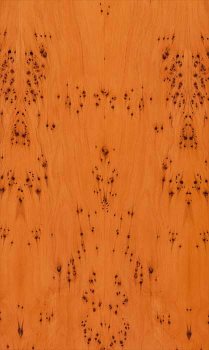Yew, European (Taxus, baccata)
Similiar Woods: American Yew, Manio
Trade Names: Yewtree, Yew
Range: Throughout Europe up to latitude 60 degrees north. Especially in England it has been cultivated for centuries because of its significance for making bow staves and as a protective tree for small game. This is why there are still large stands in England today and the reason for the country being the main supplier of yew logs. Because of its small dimensions and being very susceptible to defects such as knots, inner checking and calcerous deposits, wood suitable for slicing is very rare and corespondingly expensive. In Germany, Yew is protected by preservation rights. Largest known occurrence is in the municupal forest of Banska Bystrica (SK) with approximately 300,000 trees. All components of the tree are poisionous except for its red fruit cups. The bark of the taxus brevifolia (USA) is said to heal cancer.
Uses: A very good and expensive wood. Decorative and exclusive furniture often in the English style. Seldom possible to find clean, large surface veneer and this often used as inlays to upgrade the value of furniture. Ideal wood also fo high quality turneries and wood carvings.
Properties: Sapwood and heartwood are clearly defined. The heartwood is brownish, red-brown to orange-brown. Required in the veneer is the so-called pepper. These are tiny dots in the veneer arranged in a pattern, ideally in clusters. The annual rings are very narrow and occur as broad and deep, dark annual zones.
Machining: Yew can be easily and well machined with all tools. Planed surfaces are very smooth.
Seasoning: Due to its low shrinkage, Yew can be dried relatively free of tension.
